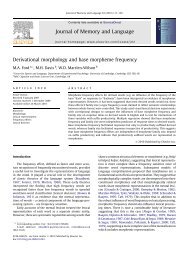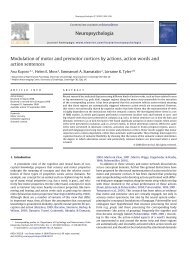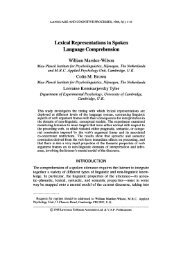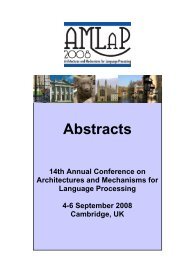Towards a psychological basis for a theory of anaphora - Centre for ...
Towards a psychological basis for a theory of anaphora - Centre for ...
Towards a psychological basis for a theory of anaphora - Centre for ...
Create successful ePaper yourself
Turn your PDF publications into a flip-book with our unique Google optimized e-Paper software.
phenomena that one is trying to explain. If such<br />
constraints tend to be missing, this is at least partly<br />
due to the failure <strong>of</strong> psychologists to provide the<br />
appropriate experimental and theoretical <strong>basis</strong> <strong>for</strong> them.<br />
Our goal here, there<strong>for</strong>e, is to point out some <strong>of</strong> the<br />
currently available processing constraints that bear on<br />
the study <strong>of</strong> <strong>anaphora</strong>.<br />
To do this, we have to start by embedding the study<br />
<strong>of</strong> <strong>anaphora</strong> in a wider context. Given our own<br />
particular psycholinguistic interests, the wider context<br />
we will define here is the general process <strong>of</strong>.spoken<br />
language understanding; that is, the ways in which<br />
human listeners perceive and interpret natural spoken<br />
language. It is, above all, important to define,, the<br />
characteristics <strong>of</strong> the processing environment in which<br />
one can suppose that anaphoric interpretation processes<br />
are operating. We begin, then, by presenting a view <strong>of</strong><br />
the speech understanding process.<br />
2. On-line Speech -- Understanding<br />
The view <strong>of</strong> speech understanding we dill present<br />
here is one that we have labelled as an "on-line<br />
interactive" approach. Both these terms carry a number<br />
<strong>of</strong> contrasts with other approaches. The term "on-line"<br />
reflects, first, our emphasis on the mental processes<br />
that take place, word-by-WO rd, m i l l isecond-bymillisecond,<br />
as the listener hears an uttzrance, and,<br />
second, the types <strong>of</strong> experimental tasks we use to<br />
investigate these processes. rypically, thesz are fast<br />
reaction-time tasks, where the subject respmds, during<br />
the perception <strong>of</strong> an utterance, to some experimentally<br />
manipulated attribute <strong>of</strong> that utterance.<br />
The reason <strong>for</strong> this methodological emphasis is that<br />
our goals are to determine what happens when during<br />
speech understanding; that is, when certain <strong>for</strong>ms <strong>of</strong><br />
analysis <strong>of</strong> the speech input can become available to the<br />
1 irltoner. 'rho tlpclueh lr\pt~C l cl 1tacun;snr L1 y t~rctcrr-13~1 it1<br />
time; thus, at any chosen moment, one can determine<br />
exactly how much <strong>of</strong> the input the listener could have<br />
heard, Given a response tapping his internal<br />
representation <strong>of</strong> the input at sotne given moment, we can<br />
then hope to capture the properties <strong>of</strong> the <strong>for</strong>ms <strong>of</strong><br />
internal representation that develop as the input is<br />
being processed. In particular, we can determine to<br />
what extent the listener's on-going processing reflects<br />
just a "bottom-up" analysis <strong>of</strong> the signal, and to what<br />
extent internally generated " top-down" inputs are also<br />
involved in on-line speech processing.<br />
The importance <strong>of</strong> using fast reaction-time tasks,<br />
in this connection, is, first, that this enables a close<br />
temporal relationship to be specified between the<br />
response and the portion <strong>of</strong> the input heard when the






